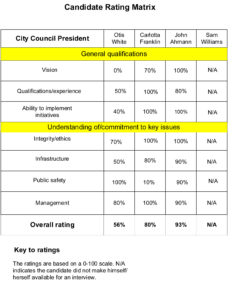Of all the things required to be a good leader in a community, here’s the one that is least discussed: courage. One reason is that it sounds so wildly out of proportion. Courage is what soldiers and fire fighters have; it’s not something we normally expect of mayors, council members, city managers, business leaders, and concerned citizens.
But should we? Courage is the mastery of fear in the service of something worthy. Physical courage in facing enemy fire or entering a burning building fits the definition. But so does social courage, which involves facing the disapproval of those we care about. This is the kind of courage that is important to communities.
That’s because, on occasion, we need respected leaders, motivated not by anger or vanity but by love, to tell us things we don’t want to hear. When time proves these leaders right, we have a special place for them in our civic memories. These are the people for whom statues are erected and streets named.
There are times when courageous leaders come forward in groups. Here in Atlanta, it was the 1950s and 1960s, when the city confronted racial segregation and, with great difficulty, defeated it. Some of these leaders became national figures—Martin Luther King, Jr., Andrew Young, Ralph Abernathy—while others are remembered mostly in Atlanta: William B. Hartsfield, Ralph McGill, Donald Hollowell, Jacob Rothschild, Eugene Patterson, Ivan Allen, Jr.
Most times, though, courageous leaders step up alone or in twos and threes, which makes their work especially lonely. Where do you see this courage?
One is in the lonely advocate, the person who sees the future more clearly than others and withstands ridicule or censure in pointing it out. The leaders of Atlanta in the 1950s and 1960s were examples. But so was Victor Steinbreuck, an architect who became in the 1960s a clarion voice for saving the buildings that made Seattle special. He became a writer and organizer, but he was also unafraid of leading protest marches. If you’ve enjoyed Pike Place Market, you can thank Victor Steinbreuck. He was instrumental in saving it from the wrecking ball.
Then there’s the opposite of the lonely advocate, the lonely opponent. This is the leader who asks us not to step forward but to step back from some action that is popular and emotionally satisfying but wrong. Take 15 minutes to read the extraordinary story of Greggor Ilagan, the young Hawaiian county council member who could not give into something his most vocal constituents wanted—and you’ll see what I mean.
Finally, there’s the lonely leader, a person who takes on a nightmare issue with no clear solutions because it’s important and no one else is stepping forward. Cook County Board President Toni Preckwinkle has done this several times in her remarkable career, including in 2013 in dealing with jail overcrowding in Chicago.
I can’t tell you where the courage of these leaders comes from. Probably from somewhere deep inside. But I can tell you what separates them from the obstinate, for which they are sometimes mistaken.
First, as I’ve already mentioned, courageous leaders act out of love, not egotism. They genuinely want to help their city with a problem that needs solving or help citizens avoid a terrible mistake. And they act reluctantly. Compare this to gadflies and political mavericks. They have no reluctance to stand against the majority; that’s their “brand.” And their actions aren’t expressions of love; they are part of their branding.
Second, the courageous ones are those who’ve studied the issue thoroughly and listened to people respectfully. That, too, is a sign of love. They are not going to put their community through the stress of controversy if it can be avoided.
Finally, time proves the courageous right. This may be a comfort to those who’ve lost their jobs because they stood for the right things, stood against the wrong, or shouldered the burdens the rest of us shirk.
Then again, perhaps these remarkable leaders don’t need comforting. After all, they have courage.
A version of this posting appeared on the Governing website.
Photo by jridgewayphotography licensed under Creative Commons.
